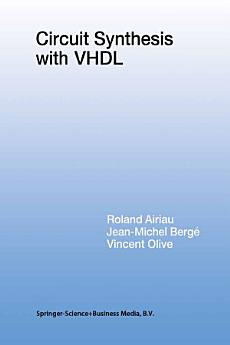Circuit Synthesis with VHDL
Roland Airiau · Jean-Michel Bergé · Vincent Olive
ธ.ค. 2012 · The Springer International Series in Engineering and Computer Science หนังสือเล่มที่ 261 · Springer Science & Business Media
5.0star
1 รีวิวreport
eBook
221
หน้า
reportคะแนนและรีวิวไม่ได้รับการตรวจสอบยืนยัน ดูข้อมูลเพิ่มเติม
เกี่ยวกับ eBook เล่มนี้
One of the main applications of VHDL is the synthesis of electronic circuits. Circuit Synthesis with VHDL is an introduction to the use of VHDL logic (RTL) synthesis tools in circuit design. The modeling styles proposed are independent of specific market tools and focus on constructs widely recognized as synthesizable by synthesis tools.
A statement of the prerequisites for synthesis is followed by a short introduction to the VHDL concepts used in synthesis. Circuit Synthesis with VHDL presents two possible approaches to synthesis: the first starts with VHDL features and derives hardware counterparts; the second starts from a given hardware component and derives several description styles. The book also describes how to introduce the synthesis design cycle into existing design methodologies and the standard synthesis environment.
Circuit Synthesis with VHDL concludes with a case study providing a realistic example of the design flow from behavioral description down to the synthesized level.
Circuit Synthesis with VHDL is essential reading for all students, researchers, design engineers and managers working with VHDL in a synthesis environment.
A statement of the prerequisites for synthesis is followed by a short introduction to the VHDL concepts used in synthesis. Circuit Synthesis with VHDL presents two possible approaches to synthesis: the first starts with VHDL features and derives hardware counterparts; the second starts from a given hardware component and derives several description styles. The book also describes how to introduce the synthesis design cycle into existing design methodologies and the standard synthesis environment.
Circuit Synthesis with VHDL concludes with a case study providing a realistic example of the design flow from behavioral description down to the synthesized level.
Circuit Synthesis with VHDL is essential reading for all students, researchers, design engineers and managers working with VHDL in a synthesis environment.
การให้คะแนนและรีวิว
5.0
1 รีวิว
ให้คะแนน eBook นี้
แสดงความเห็นของคุณให้เรารับรู้
ข้อมูลในการอ่าน
สมาร์ทโฟนและแท็บเล็ต
ติดตั้งแอป Google Play Books สำหรับ Android และ iPad/iPhone แอปจะซิงค์โดยอัตโนมัติกับบัญชีของคุณ และช่วยให้คุณอ่านแบบออนไลน์หรือออฟไลน์ได้ทุกที่
แล็ปท็อปและคอมพิวเตอร์
คุณฟังหนังสือเสียงที่ซื้อจาก Google Play โดยใช้เว็บเบราว์เซอร์ในคอมพิวเตอร์ได้
eReader และอุปกรณ์อื่นๆ
หากต้องการอ่านบนอุปกรณ์ e-ink เช่น Kobo eReader คุณจะต้องดาวน์โหลดและโอนไฟล์ไปยังอุปกรณ์ของคุณ โปรดทำตามวิธีการอย่างละเอียดในศูนย์ช่วยเหลือเพื่อโอนไฟล์ไปยัง eReader ที่รองรับ










